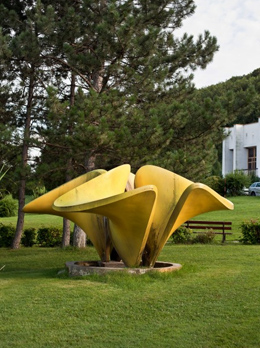
The exhibition presents public sculptures from the era of socialism
 |
"We wanted to present models of the most interesting buildings of that time, which, however, was not entirely possible because many of the models were made of plaster, which have not been preserved or were lost for various reasons," said the exhibition curator Ivona Raimanová. In the end, the exhibition includes 130 models by 47 authors of sculptures that were either realized or went through a public competition but were not selected. Many of the authors came to see the exhibition today. Pavel Karous also reminded that only in Prague, 1500 sculptures were realized from 1970 to 1990. In contrast, after 1990, only 56 sculptures emerged from similar competitions. This is a difference not only quantitative but also qualitative, as the commissions of the competitions at that time, despite all the ideology, consisted of experts, artists, and sculptors, whereas today officials primarily decide about public sculptures, said Karous, adding that, conversely, 450 similar artworks have been removed from public space in various ways over the past twenty years.
Monumental art went through a period of normalization stagnation in the 70s and 80s after a period of great experimental ferment in the 60s. At the same time, however, there were never so many competitions organized, nor so many orders of a social nature. Many kitsch and low-quality works emerged then, but among them, sculptures also appeared that reflected current global trends.
The quantity of commissions was ensured from 1965 by a law that required every state building to allocate one to four percent of the budget for decoration. "Four percent art" thus created aesthetic dominants of the emerging housing estates, polyclinics, department stores, and other buildings. The state thus provided work for trained artists, wanting to secure their loyalty while using them for its promotion. In a flood of stereotypical realizations, extraordinarily high-quality and daring works were also created that surpassed the time of their origin.
Pavel Karous divides normalization sculptures into categories based on nicknames given to them by contemporary folklore. For example, a girl sitting in a squat was referred to by people as "Lost the Keys." In the streets, one can encounter the "Hip Joint of a Mammoth," "Triffids," or "Aliens." The latter creature is seen by some in the eggs, originally intended as a symbol of fertile communist power and creativity. The titular Herons then depict water birds cleverly combined with pools, water tanks, and fountains. However, according to Karous, Herons had a dual significance - they managed to divert attention from the bolder part of the sculpture, which would not have passed on its own.
The exhibition is designed as a studio of late modern artists, featuring models of objects for architecture with which artists competed. The exhibition includes works by Czech and Slovak sculptors Miroslav Chlupáč, Eva Kmentová, Věra Janoušková, Karel Malich, Jozef Jankovič, Mária Bartuszová, Jaroslava Brychtová, Stanislav Libenský, Karel Nepraš, Kurt Gebauer, Elena Jilemnická, Vratislav Karl Novák, Stefan Milkov, Jaroslav Róna, Čestmír Suška, and others.
The English translation is powered by AI tool. Switch to Czech to view the original text source.
0 comments
add comment
Related articles
0
08.04.2020 | In her 95th year, glass artist Jaroslava Brychtová passed away
0
08.04.2020 | Glass is beautiful, noble, and a rascal, claimed Jaroslava Brychtová
0
17.07.2019 | <p>P95th anniversary is celebrated by glass artist Jaroslava Brychtová.</p>
0
09.04.2017 | Prague is considering whether to use funds for art to also cover the maintenance of works
0
08.11.2014 | ARCHIP - Aliens and Herons
0
07.01.2014 | Praha 6 wants a monument to the Austrian and Czech ruler Maria Theresa






